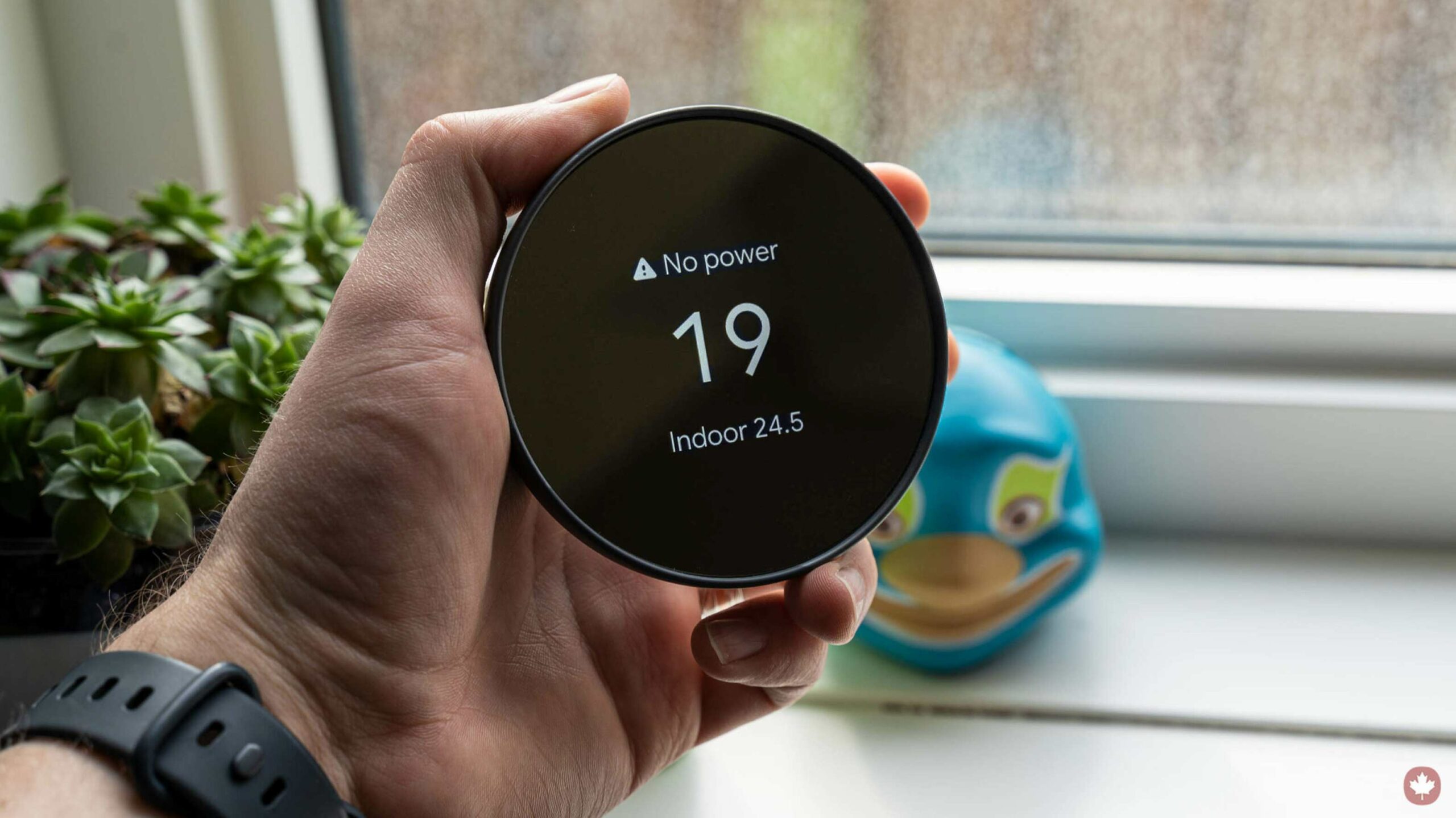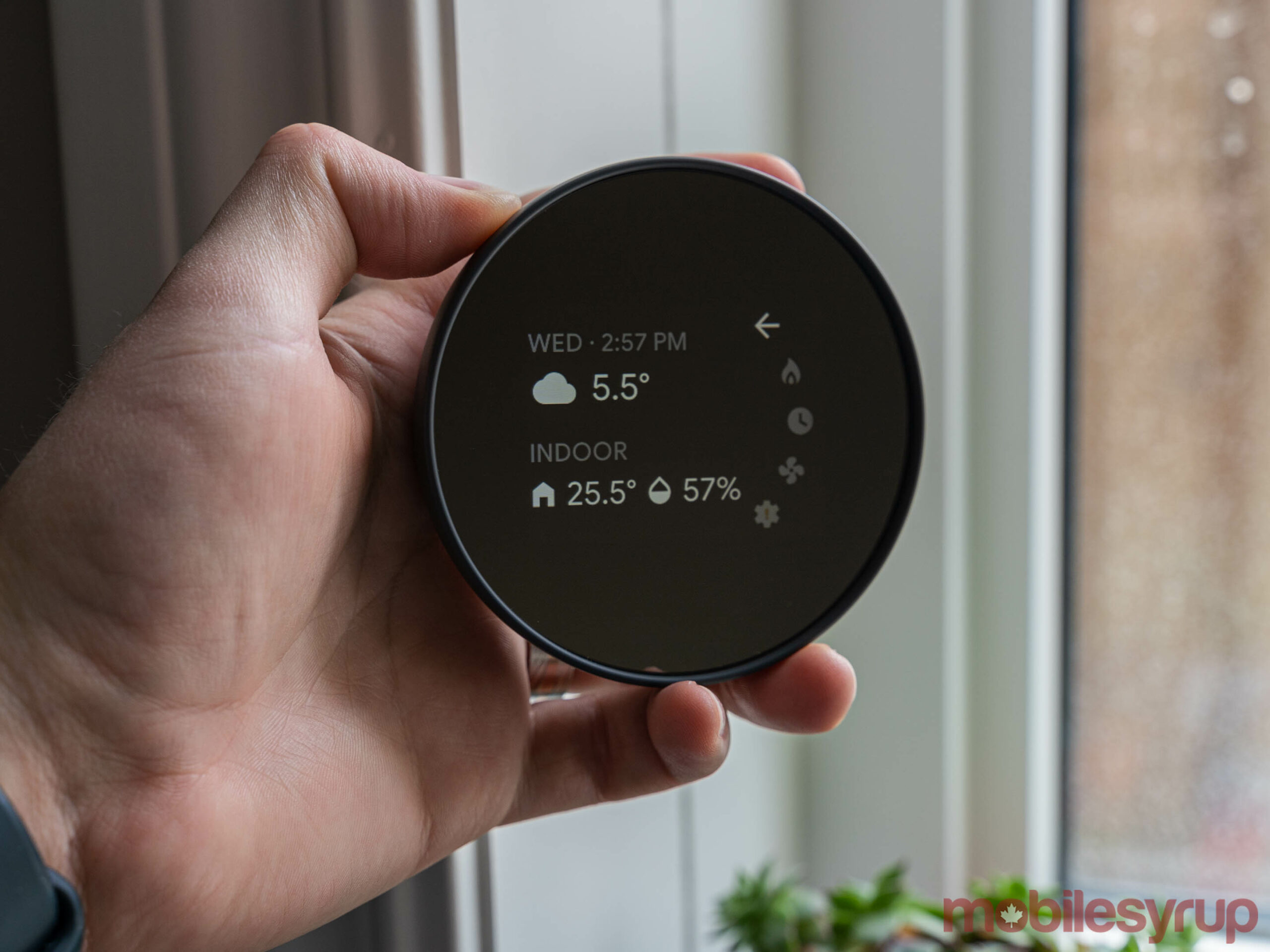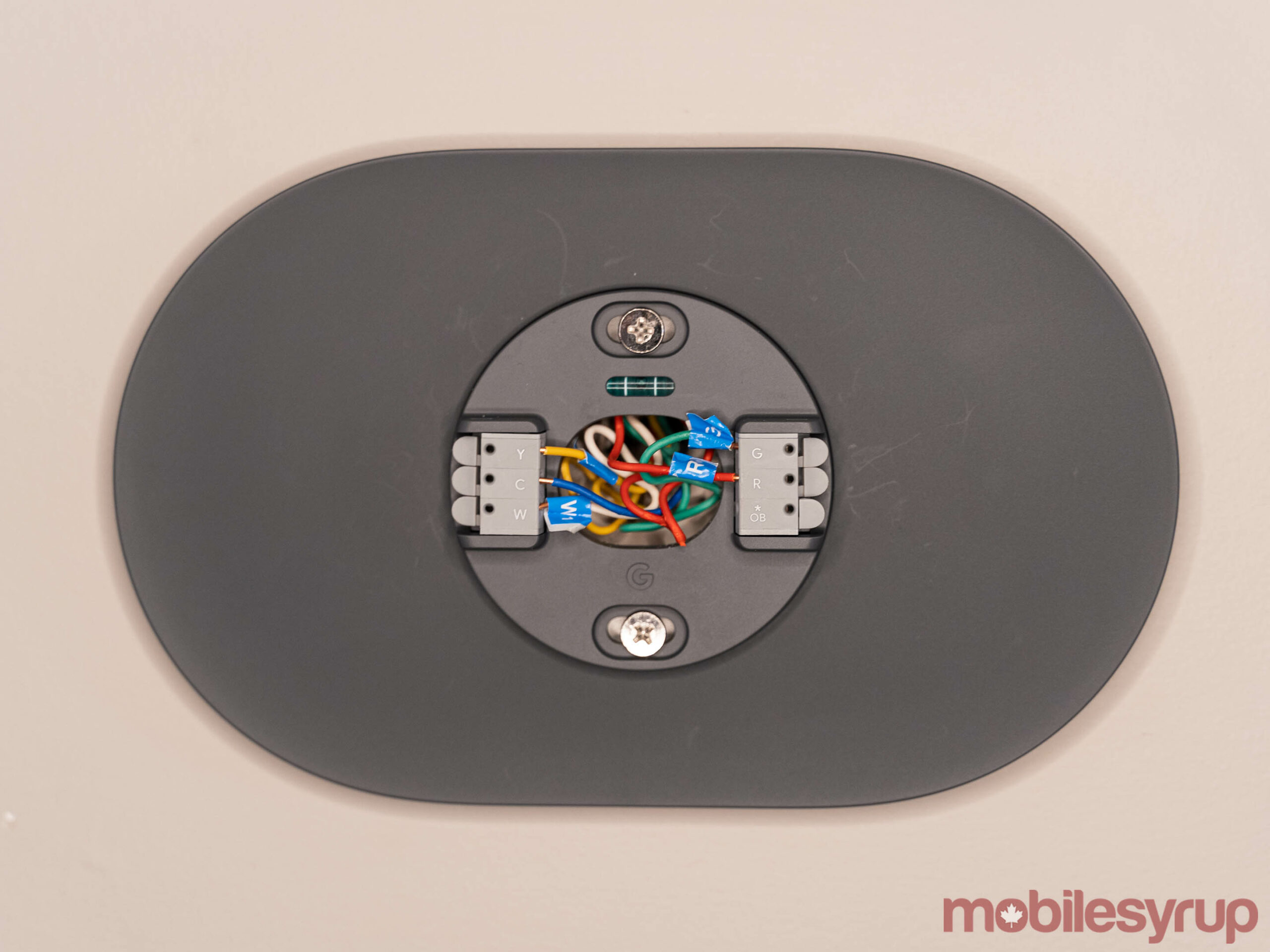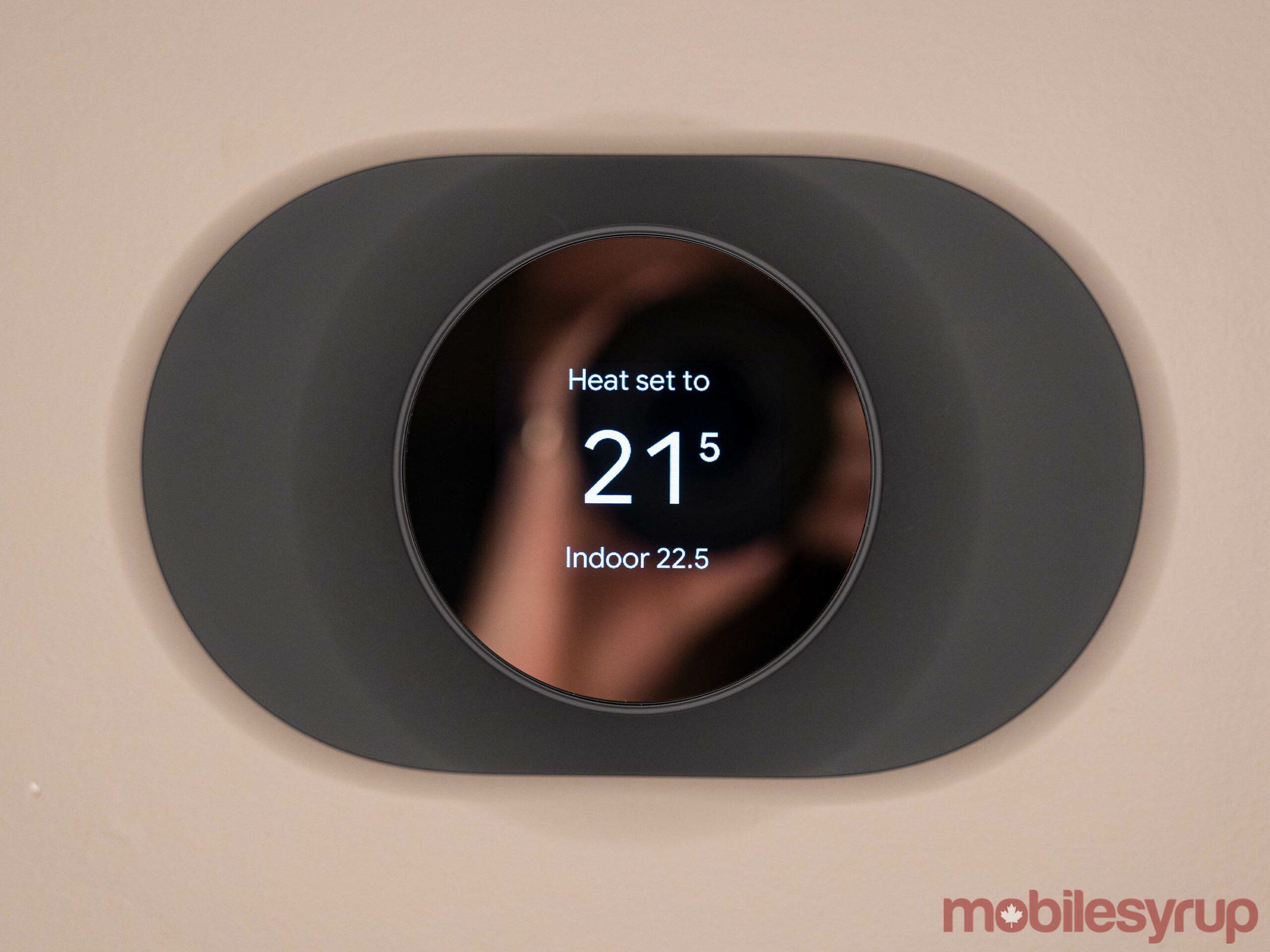
The Pros
- More affordable
- Unique design
- Simple set up process
The Cons
- Not has 'smart' as other options
- No support for temperature sensors
- Presence sensing can be unreliable
Last year, Google released a new, lower-cost Nest Thermostat.
Coming in at $50 less than the Nest Thermostat E (which is no longer available) and $150 less than the Nest Learning Thermostat, the new — and somewhat confusingly named — Nest Thermostat offers a more affordable option for Canadians looking to get a smart thermostat.
However, smart may be a bit of a stretch for the Thermostat. It is a smart thermostat by all metrics, but Google trimmed some of the smartest features to shrink the cost. The Nest Thermostat would be better classified as a connected thermostat as that’s the main benefit it offers over the typical thermostat someone might already have.
Don’t get me wrong, upgrading from a ‘dumb’ thermostat to a Nest Thermostat is still an upgrade. For most people, it comes down to whether the Nest Thermostat’s smart features are worth its $179.99 cost, and whether the more expensive Nest Learning Thermostat will serve their needs better.
Putting the temperature in the palm of your hand

First and foremost, the Nest Thermostat’s most significant advantage over a regular thermostat is that you can control it from your smartphone. Specifically, the Google Home app includes everything you need to manage the Nest Thermostat. Anyone who has a Google smart device (Chromecast, smart speakers, etc.) likely already has this app and uses it regularly. As someone who uses Google to manage my smart home devices, not needing an extra app was a blessing.
Sure, dumb thermostats don’t need an app at all, but you also have to physically use the thermostat on the wall to change the temperature. The benefit of managing temperature from anywhere goes far beyond turning up the heat from the comfort of your couch. For example, if you’re away from home for a few days, you can check-in on the app and make sure everything’s still working fine. If the heat cuts out in your home during a Canadian winter, it can be disastrous.
Further, the Nest Thermostat works great with Google Home speakers. With a few voice commands, I can check the temperature, change it and more. Perhaps my favourite discovery was that the Nest Hub I keep on my desk features a handy quick-access toggle. When I’m working, I can simply swipe the display, check the temperature and adjust it with a tap.
A great thermostat, but not flawless

As great as these controls are, they’re unfortunately about the extent of the Nest Thermostat’s ‘smart’ capabilities. It also offers HVAC system monitoring, which means the Thermostat will recognize subtle patterns in your heating and cooling systems and provide suggestions on what maintenance to do. However, I haven’t had the review unit long enough to receive any of these alerts.
The other prominent smart feature is presence detection, which uses a combination of a Soli radar sensor in the Nest Thermostat plus your smartphone’s location captured by the Google Home app to detect when you’re home or away. When you leave your house, the Nest Thermostat will switch to the ‘Eco’ preset to save energy (we’ll get more into the presets below).
Speaking of the presence sensing, I encountered a couple instances where the thermostat decided I’d left the house and went into Eco mode. With the ongoing pandemic, both my wife and I work from home and only leave for necessities — when we do leave, the presence sensing works well. It’s not so great when we’re both sitting in our office working and wondering why it’s suddenly so chilly.
The Nest Learning Thermostat can do a bit more, including automatic temperature adjustments based on how you use it (thus the ‘learning’ moniker). It can also interface with the Nest Temperature Sensor to get better data on your house’s temperature. If you want these extra features, then the Nest Thermostat is not for you.
Easy to set up, even if you don’t know what you’re doing

Setting up the Nest Thermostat in my apartment was perhaps the most stressful and challenging part of testing the device, and it actually went way smoother than I anticipated.
That’s a testament to how much effort Google put into making set-up a breeze. Honestly, the experience is stellar. The Google Home app walks you through every step, showing animated illustrations to guide you. There was only one situation where I was confused during the set-up, primarily because of my old thermostat and not the Nest. That said, if you’re not comfortable with some basic wiring tasks, you may prefer to hire someone to install it for you. It’s worth noting that the Nest Thermostat comes with batteries and, according to a Google Nest Help page, shouldn’t need a ‘C wire’ or common wire for power, with some exceptions.
Although easy to install, the Nest Thermostat set-up isn’t perfect. For one, Google estimates it’s compatible with about 85 percent of heating and cooling systems, compared to 95 percent with the Nest Learning Thermostat (the company offers a compatibility checker here — you should use it before making a purchase).

The other major grievance I had with the Nest Thermostat was that the trim plate wasn’t included. Granted, it only costs $19.99, and I received one with the review unit, but it’s a frustrating extra cost for anyone else.
Part of set-up includes creating temperature presets and a schedule for the Nest Thermostat to cycle through. Users can create two sets of three preset temperatures with the Nest, one for heating and one for cooling. Each set includes the ‘Comfort’ option, which is the default temperature the Nest Thermostat tries to maintain. After setting up the thermostat, users can also create custom presets in the Google Home app.
There’s also the ‘Eco’ preset, which is meant to activate when users are away from their homes. The idea is Eco keeps your house warmer or cooler (depending on the season) than usual when you’re not around to lower your energy bill. Finally, there’s a Sleep preset to use at night. When setting up the presets, Google makes recommendations based on common settings and heating/cooling trends.
Stylish, even if it is plastic

Although not everyone agrees, I actually quite like the Nest Thermostat design. Yes, it’s not as nice as the Nest Learning Thermostat. However, the new Nest Thermostat is quite stylish in plastic.
The Nest Thermostat design’s biggest downside is Google ditched the rotating outer ring featured on the Nest Learning Thermostat. Although the Nest Thermostat’s touch-based control system works well, it’s nowhere near as satisfying as spinning that physical dial. That said, I also rarely interacted directly with the Nest Thermostat on the wall. Instead, I made most temperature adjustments from my phone or smart display.
I also like the mirror-like finish on the Nest Thermostat. It gives the device a unique look, almost like the temperature is hovering in this pane of glass. Unfortunately, looking at the Nest Thermostat in specific lighting or from certain angles lets you see the screen hidden beneath the reflective finish, spoiling the illusion.
Finally, Google offers a variety of lovely colours, including ‘Snow,’ ‘Sand,’ ‘Fog’ and ‘Charcoal.’ It shouldn’t be too hard to find a Nest Thermostat that fits in well with your home.
Excellent entry-level connected thermostat
All in, Google's Nest Thermostat is a great entry-level option. For many people toying with the idea of getting a smart thermostat, I think the Nest offers a more affordable way to get into the basic connected features without all the extra intelligence.
Toronto’s ecobee also offers a variety of smart thermostats, with its ecobee3 lite being the closest to the Nest Thermostat in terms of price (it comes in at $219.99 CAD). The ecobee offers some capabilities beyond what the Nest Thermostat can do, like support for ecobee’s ‘SmartSensors.’ That said, Nest Thermostat can automatically change temperatures when you leave or come home, while the ecobee3 lite requires the extra SmartSensor to do that, and both the Nest Thermostat and ecobee offer the ability to start heating or cooling early to reach the desired temperature at the scheduled time.
If you’re trying to decide between the two, definitely spend some time reading through the specs and capabilities. There are subtle but important differences to consider.
The Nest Thermostat is especially useful for those already deeply invested in a Google-based smart home ecosystem. The Nest Thermostat fits in nicely thanks to its deep integration with the Google Home app.
However, anyone looking for intelligent thermostat features, or anything beyond basic smartphone controls, will likely want to look elsewhere. The Nest Thermostat offers a lot of convenience, but in practice, it mostly moves manual controls off the wall and onto your phone.
Nest Thermostat costs $179.99 and is available from the Google Store, Best Buy, Lowes and more.
Update 03/03/2021 at 5:13pm: Corrected the review to note that the Nest Thermostat offers both 'Early On,' which is similar to ecobee's 'Smart Recovery,' as well as an option to add custom presets.
Google's Nest Thermostat is a great entry-level option for those who want some basic smart features at an affordable price.
MobileSyrup may earn a commission from purchases made via our links, which helps fund the journalism we provide free on our website. These links do not influence our editorial content. Support us here.


